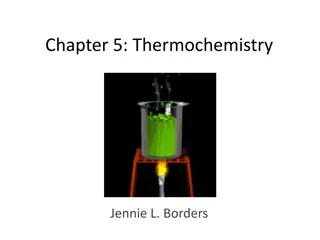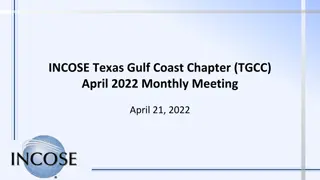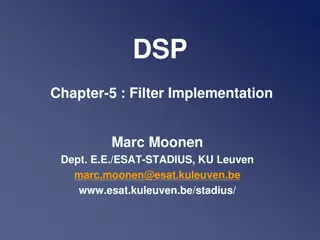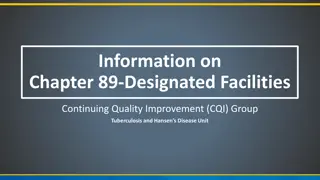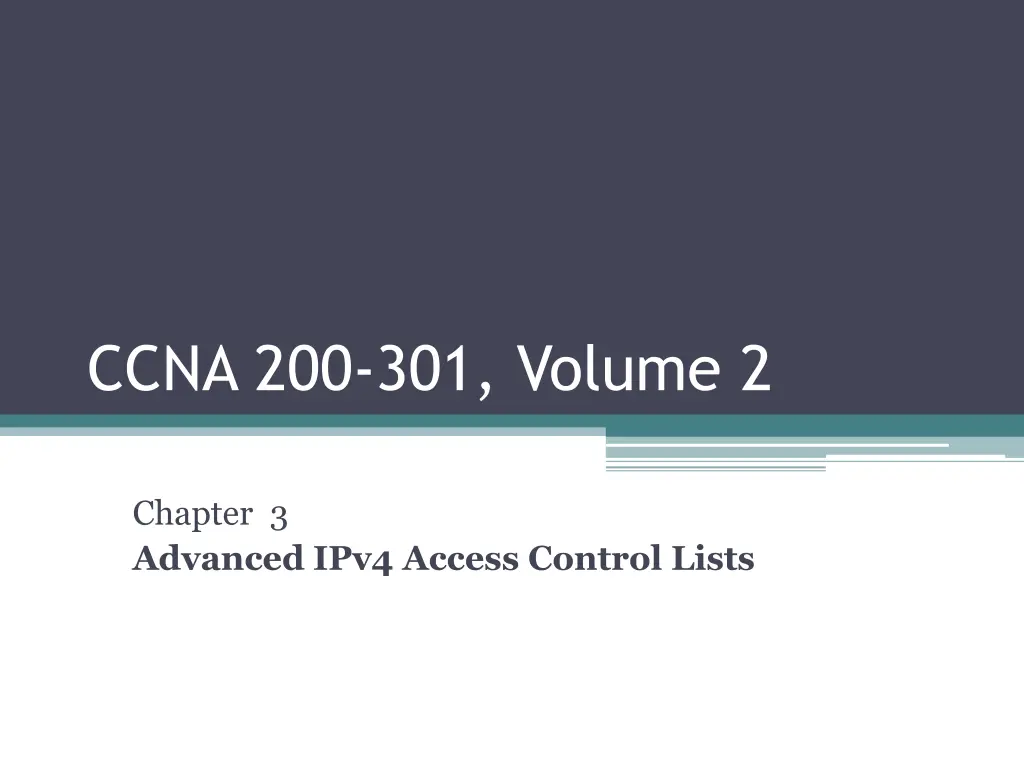
Advanced IPv4 Access Control Lists Overview
Explore the advanced concepts of IPv4 access control lists (ACLs), including configurations, comparisons of ACL types, IP header requirements, extended ACL syntax, and filtering packets based on port numbers. Dive into popular applications and their associated well-known port numbers to enhance your networking knowledge.
Download Presentation

Please find below an Image/Link to download the presentation.
The content on the website is provided AS IS for your information and personal use only. It may not be sold, licensed, or shared on other websites without obtaining consent from the author. If you encounter any issues during the download, it is possible that the publisher has removed the file from their server.
You are allowed to download the files provided on this website for personal or commercial use, subject to the condition that they are used lawfully. All files are the property of their respective owners.
The content on the website is provided AS IS for your information and personal use only. It may not be sold, licensed, or shared on other websites without obtaining consent from the author.
E N D
Presentation Transcript
CCNA 200-301, Volume 2 Chapter 3 Advanced IPv4 Access Control Lists
Objectives Configure and verify access control lists
IP Header, with Focus on Required Fields in Extended IP ACLs
Extended access-list Commands and Logic Explanations access-list Statement What it Matches access-list 101 deny tcp any any Any IP packet that has a TCP header access-list 101 deny udp any any Any IP packet that has a UDP header access-list 101 deny icmp any any Any IP packet that has an ICMP header access-list 101 deny ip host 1.1.1.1 host 2.2.2.2 All IP packets from host 1.1.1.1 going to host 2.2.2.2, regardless of the header after the IP header access-list 101 deny udp 1.1.1.0 0.0.0.255 any All IP packets that have a UDP header following the IP header, from subnet 1.1.1.0/24, and going to any destination
IP Header, Followed by a TCP Header and Port Number Fields
Extended ACL Syntax with TCP and UDP Port Numbers Enabled
Popular Applications and Their Well- Known Port Numbers Port Number(s) Protocol Application access-list Command Keyword 20 TCP FTP Data ftp-data 21 TCP FTP control ftp 22 TCP SSH -- 23 TCP Telnet telnet 25 TCP SMTP smtp 53 UDP, TCP DNS domain 67 UDP DHCP Server bootps 68 UDP DHCP Client bootpc
Popular Applications and Their Well- Known Port Numbers (continued) Port Number(s) Protocol Application access-list Command Keyword tftp 69 UDP TFTP 80 TCP HTTP (WWW) www 110 TCP POP3 pop3 161 UDP SNMP snmp 443 TCP SSL -- 514 UDP Syslog -- 16,384-32,767 UDP RTP (Voice, Video) --
Extended access-list Command Examples and Logic Explanations access-list Statement What It Matches access-list 101 deny tcp any gt 49151 host 10.1.1.1 eq 23 Packets with a TCP header, any source IP address, with a source port greater than (gt) 1023, a destination IP address of exactly 10.1.1.1, and a destination port equal to (eq) 23. access-list 101 deny tcp any host 10.1.1.1 eq 23 The same as the preceding example, but any source port matches, because that parameter is omitted in this case. access-list 101 deny tcp any host 10.1.1.1 eq telnet The same as the preceding example. The telnet keyword is used instead of port 23. access-list 101 deny udp 1.0.0.0 0.255.255.255 lt 1023 any A packet with a source in network 1.0.0.0/8, using UDP with a source port less than (lt) 1023, with any destination IP address.
Extended IP Access List Configuration Commands Command Configuration Mode and Description Global command for extended numbered access lists. Use a number between 100 and 199 or 2000 and 2699, inclusive. A version of the access-list command with parameters specific to TCP and/or UDP. access-list access-list-number {deny | permit} protocol source source-wildcard destination destination-wildcard [log | log- input] access-list access-list-number {deny | permit} {tcp | udp} source source-wildcard [operator [port]] destination destination- wildcard [operator [port]] [established] [log]
Network Diagram for Extended Access List Example 1
R3s Extended Access List Stopping Bob from Reaching FTP Servers Near R1
Network Diagram for Extended Access List Example 2
Yosemite Configuration for Extended Access List Example 2
Building One-Line Extended ACLs: Practice Problem Criteria 1 From web client 10.1.1.1, sent to a web server in subnet 10.1.2.0/24. 2 From Telnet client 172.16.4.3/25, sent to a Telnet server in subnet 172.16.3.0/25. Match all hosts in the client s subnet as well. 3 ICMP messages from the subnet in which 192.168.7.200/26 resides to all hosts in the subnet where 192.168.7.14/29 resides. 4 From web server 10.2.3.4/23 s subnet to clients in the same subnet as host 10.4.5.6/22. 5 From Telnet server 172.20.1.0/24 s subnet, sent to any host in the same subnet as host 172.20.44.1/23.
Building One-Line Extended ACLs: Practice (continued) Problem Criteria 6 From web client 192.168.99.99/28, sent to a web server in subnet 192.168.176.0/28. Match all hosts in the client s subnet as well. 7 ICMP messages from the subnet in which 10.55.66.77/25 resides to all hosts in the subnet where 10.66.55.44/26 resides. 8 Any and every IPv4 packet.
Named ACL vs. Numbered ACL Configuration
Removing One Command from a Named ACL
Editing ACLs Using Sequence Numbers (continued)
Adding To and Displaying a Numbered ACL Configuration
General Recommendations for ACL Implementation Place extended ACLs as close as possible to the source of the packet. Place standard ACLs as close as possible to the destination of the packet. Place more specific statements early in the ACL. Disable an ACL from its interface (using the no ip access-group interface subcommand) before making changes to the ACL.





